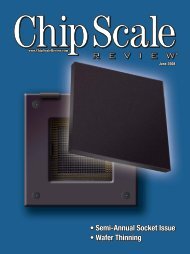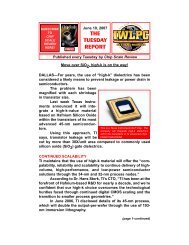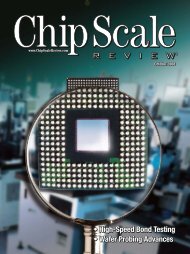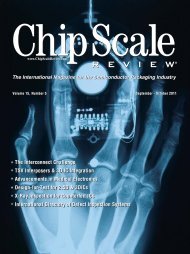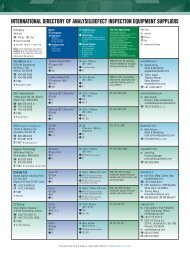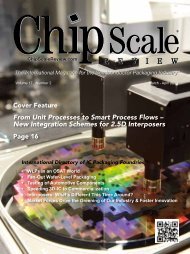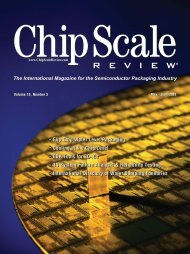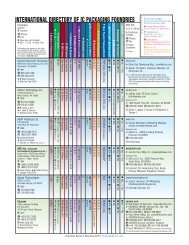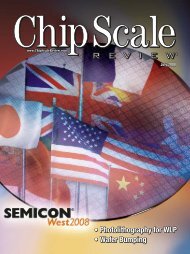Figure 10. Cross section showing the highaspect ratio (13.3/1) TSVThin Wafer HandlingTo have high performance, low profile,and lightweight products with 3D ICintegration technology, the thickness of thechips/wafers is usually very thin. Making awafer thin is not a big problem. Most of theback-grinding machines can do the job andgrind the wafers to as thin as 5μm. However,handling thin wafers through all thesemiconductor fabrication and packagingassembly processes is difficult. Usually, thethin wafer is temporarily bonded on asupport wafer. Then it goes through all thesemiconductor fabrication processes suchas metallization, passivation and UBM, andthe packaging processes such asbackgrinding and solder bumping. After allthese, removing the thin wafer from thesupport wafer poses another big challenge.Two equipment groups are available forthin-wafer handling today, namely,3M+SUSS and EVG+Brewer Science.Figure 11 shows a very simple and lowcostsupport-wafer method for thin-wafer(50μm) handling. In order to reduce theresidual stress and remain crack-free duringde-bonding, one must reduce the pitch ofthe release holes (1mm in diameter) on theperforated wafer to 2mm and increase thenumber of perforations on the edge of theFigure 11. A low-cost, thin-wafer handlingmethodsupport wafer. These two optimizeddebonding methods allow more chemicalsolution to uniformly penetrate into thebonding adhesive and eventually debondthe wafer successfully 10 .Low-cost, Lead-free SolderMicrobumpsFor 3D IC integration, chips are verythin and thus conventional flip-chipsolder bumps (~100μm) cannot beused. Instead, very tiny bumps (
integration technology is far in thefuture. The electronics industry shouldstrive to make more high-volumeproducts with 3D IC integrationtechnology5. IC chip yield (Y T) plays the most importantrole in TSV manufacturing cost. If Y Tislow for a particular IC device, then it isnot cost effective to use the TSVtechnology (because it makes the gooddice too expensive), unless it iscompensated for by density,performance, weight, and form factor.6. TSV manufacturing yield (Y TSV) plays thesecond most important role in TSVmanufacturing cost. Since this is the firstpost-wafer processing after the ICsemiconductor fabs, the packagingassembly and test houses should striveto make Y TSV> 99.99%. Otherwise, it willmake the subsequent steps veryexpensive by wasting material andprocess on the damaged TSV dice.7. Wafer-bumping yield (Y B> 99.99%) playsthe third most important role in TSVmanufacturing cost. The waferbumping/packagingassembly and testhouses should strive to make Y TSVY B>99.98% to minimize the hidden cost,since they cannot afford to damage gooddice already having TSVs.8. Dates in the 3D IC integration roadmapmost likely will be postponed becauseof the tough requirements of TSVmanufacturing yield (YTSV > 99.99%)and the very high hidden costs 2 .9. Based on what happened about 20 yearsago to the low-cost, solder-bump, flipchip,and wafer-level packagingtechnologies, it will not be a surprise tosee that, at the early stage,semiconductor foundries would like todo TSV and wafer bumping, but whenthe volumes pick up, the packagingassembly and test houses will do it allbecause they are flexible. Also, their corecompetence and major business are tobuild packages for the chips from thewafers given (made and tested) by thesemiconductor foundries and to performthe final packaging test. Then they shiponly the good ones to EMS (electronicsmanufacturing services) who performthe PCB assembly, in-circuit test, system(also called final or functional) test, andship the product to the system houses’hubs for distribution. Some systemhouses prefer to have their EMS shipthem the in-circuit tested good PCBs,perform the final test in-house, and thenship the product. This is theinfrastructure and how the electronicsindustry works. Of course, for somespecial reasons or niche applications,there are always a few exceptions.AppendixThere are at least two different vias on achip. One is very tiny (< 0.1μm today) and theother is very large (> 5μm today). The tinyones are connected to devices such astransistors (4 tiny vias for each transistor) tobuild the first metal layer (Figure 15). Today,the number of these tiny vias, for many chips,already exceeds the world population of over7 billion. On the other hand, for the large viasthat we call TSV for 3D IC integration, thenumber is much less (< 100,000 today) andthe size is larger (a 5μm TSV is shown inFigure 15 to show their contrast). Foundriesare too expensive to make 3D IC integrationTSVs. This is also true for the via-middleapproach, which makes the TSVs before themetal layers.AcknowledgementThe author would like to thank Ian Yi-JenChan, PhD, of the Electronics &Optoelectronics Labs of ITRI for his strongsupport. He also would like to thank X.Zhang, PhD, and A. Yu, PhD, for their usefuldiscussions.References1. Lau, J. H., Reliability of RoHS Compliant2D & 3D Electronic Interconnects,McGraw-Hill, New York, NY, <strong>2010</strong>.2. Lau, J. H., “TSV Manufacturing Yieldand Hidden Costs for 3D IC Integration”,to be published in the IEEE Proceedingsof Electronic, Components &Technology Conference, Las Vegas, NV,June <strong>2010</strong>.3. Akasaka, Y., “Three-dimensional ICTrends”, Proceedings of the IEEE, Vol.74, No. 12, December 1986, pp. 1703-1714.4. Chen, K., S. Lee, P. Andry, C. Tsang, A.Topop, Y. Lin, Y., J. Lu, A. Young, M.,Ieong, and W. Haensch, W., “Structure,Design and Process Control for CuBonded Interconnects in 3D IntegratedCircuits”, IEEE Proceedings of<strong>Chip</strong> <strong>Scale</strong> <strong>Review</strong>. <strong>March</strong>/<strong>April</strong> <strong>2010</strong> . [<strong>Chip</strong><strong>Scale</strong><strong>Review</strong>.com] 27



